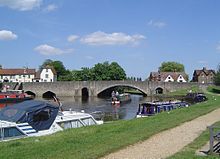Abingdon Bridge
| Abingdon Bridge | |
|---|---|

Abingdon Bridge, looking downstream from the top of Nag's Head Island
|
|
| Coordinates | 51°40′07″N 1°16′46″W / 51.6686°N 1.2795°WCoordinates: 51°40′07″N 1°16′46″W / 51.6686°N 1.2795°W |
| Carries | A415 road |
| Crosses | River Thames |
| Locale | Abingdon, Oxfordshire |
| Maintained by | Oxfordshire County Council |
| Heritage status | Grade II listed |
| Characteristics | |
| Design | Arch bridge |
| Material | stone |
| No. of spans | 6 |
| Piers in water | 5 |
| History | |
| Construction begin | 1416 |
| Construction end | 1422, rebuilt 1927 |
| Burford Bridge | |
|---|---|

Burford Bridge at Abingdon from downstream
|
|
| Heritage status | Grade II listed |
| Characteristics | |
| Design | Arch bridge |
| Material | stone |
| Height | 13 feet 11 inches (4.24 m) |
| No. of spans | 7 |
| Piers in water | 3 |
| History | |
| Construction end | 1453, rebuilt 1927 |
Abingdon Bridge crosses the River Thames at the town of Abingdon, Oxfordshire, England. It carries the A415 road from Abingdon to Dorchester, Oxfordshire, over the reach of the Thames between Culham Lock and Abingdon Lock.
The bridge is actually two bridges, linked by Nag's Head Island. Abingdon Bridge is the northern part towards the town which has six arches and crosses the backwater and mill stream. The southern part is technically called Burford Bridge and has one main arch and four minor arches at the river and two minor arches on the floodplain. This crosses the main navigation channel. Furthermore, to complete the Thames crossing, Culham Bridge crossing the Swift Ditch should also be considered as an extension.
Abingdon Bridge was begun in 1416 and completed in 1422, using local limestone quarried at Besselsleigh and Dry Sandford. The bridge was funded by Abingdon's religious guild, the Fraternity of the Holy Cross, and chiefly by two of the guild's members: a London merchant called William Hales and his wife Maud. The bridge replaced a ferry and its completion severely reduced trade at Wallingford.
In 1453 "three new arches" were added at the southern end of the bridge, this becoming known as Burford Bridge. This description makes no reference to the two pairs of much small arches to each side of the central arches. In 1548 during the Edwardine Reformation the Crown suppressed the Fraternity of the Holy Cross. In 1553 a Royal charter founded Christ's Hospital to replace the guild and take over most of its property and functions, including custody and maintenance of Abingdon's bridges.
...
Wikipedia
